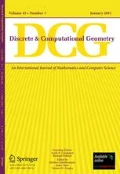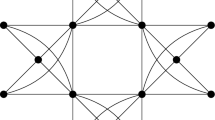Abstract
This work is about graphs arising from Reuleaux polyhedra. Such graphs must necessarily be planar, 3-connected and strongly self-dual. We study the question of when these conditions are sufficient. If G is any such graph, each vertex has an opposite face with isomorphism \(\tau :G \rightarrow G^*\) (where \(G^*\) is the unique dual graph), a metric mapping is a map \(\eta :V(G) \rightarrow \mathbb R^3\) such that the diameter of \(\eta (G)\) is 1 and for every pair of vertices (u, v) such that \(u\in \tau (v)\) we have \({{\,\mathrm{dist}\,}}{(\eta (u),\eta (v))}= 1\). If \(\eta \) is injective, it is called a metric embedding. Our contributions are twofold: Firstly, we prove that any planar, 3-connected, strongly self-dual graph has a metric mapping to the vertices of a tetrahedron. Secondly, we develop algorithms that allow us to obtain every such graph with up to 14 vertices and we construct (numerically) metric embeddings for it. From these two facts we conjecture that every such graph is realizable as a Reuleaux polyhedron in \(\mathbb R^3\). In previous work the first and last authors described a method to construct a constant-width body from a Reuleaux polyhedron. So in essence, we also construct (numerically, but with very high precision) hundreds of new examples of constant-width bodies.





Similar content being viewed by others
References
Anciaux, H., Guilfoyle, B.: On the three-dimensional Blaschke–Lebesgue problem. Proc. Am. Math. Soc. 139(5), 1831–1839 (2011)
Asimow, L., Roth, B.: The rigidity of graphs. Trans. Am. Math. Soc. 245, 279–289 (1978)
Bezdek, K., Lángi, Z.S., Naszódi, M., Papez, P.: Ball-polyhedra. Discrete Comput. Geom. 38(2), 201–230 (2007)
Bezdek, K., Naszódi, M.: Rigidity of ball-polyhedra in Euclidean \(3\)-space. Eur. J. Combin. 27(2), 255–268 (2006)
Brinkmann, G., McKay, B.D.: Fast generation of planar graphs. MATCH Commun. Math. Comput. Chem. 58(2), 323–357 (2007)
Chakerian, G.D., Groemer, H.: Convex bodies of constant width. Convexity and its Applications, pp. 49–96. Birkhäuser, Basel (1983)
Gruenbaum, B.: A proof of Vázsonyi’s conjecture. Bull. Res. Council Isr. Sect. A 6, 77–78 (1956)
Heppes, A.: Beweis einer Vermutung von A. Vázsonyi. Acta Math. Acad. Sci. Hung. 7, 463–466 (1956)
Kupitz, Y.S., Martini, H., Perles, M.A.: Ball polytopes and the Vázsonyi problem. Acta Math. Hung. 126(1–2), 99–163 (2010)
Lovász, L.: Kneser’s conjecture, chromatic number, and homotopy. J. Comb. Theory Ser. A 25(3), 319–324 (1978)
Lovász, L.: Self-dual polytopes and the chromatic number of distance graphs on the sphere. Acta Sci. Math. (Szeged) 45(1–4), 317–323 (1983)
Mackworth, A.K.: Consistency in networks of relations. Artif. Intell. 8(1), 99–118 (1977)
Martini, H., Montejano, L., Oliveros, D.: Bodies of Constant Width. Birkhäuser, Cham (2019)
Montejano, L., Roldán-Pensado, E.: Meissner polyhedra. Acta Math. Hung. 151(2), 482–494 (2017)
Sallee, G.T.: Reuleaux polytopes. Mathematika 17, 315–323 (1970)
Servatius, B., Servatius, H.: The \(24\) symmetry pairings of self-dual maps on the sphere. Discrete Math. 140(1–3), 167–183 (1995)
Servatius, B., Servatius, H.: Self-dual graphs. Discrete Math. 149(1–3), 223–232 (1996)
Storn, R.: On the usage of differential evolution for function optimization. In: Proceedings of North American Fuzzy Information Processing, pp. 519–523. IEEE (1996)
Storn, R., Price, K.: Differential evolution—a simple and efficient heuristic for global optimization over continuous spaces. J. Glob. Optim. 11(4), 341–359 (1997)
Straszewicz, S.: Sur un probleme géométrique de P. Erdös. Bull. Acad. Polon. Sci. Cl. III 5, 39–40 (1957)
Whitney, H.: \(2\)-Isomorphic graphs. Am. J. Math. 55(1–4), 245–254 (1933)
Author information
Authors and Affiliations
Corresponding author
Additional information
Editor in Charge: János Pach
Publisher's Note
Springer Nature remains neutral with regard to jurisdictional claims in published maps and institutional affiliations.
Dedicated to the memory of Ricky Pollack
This research was supported by PAPIIT Projects IA102118, IN112614 and IN116919, and CONACyT Project 166306.
Rights and permissions
About this article
Cite this article
Montejano, L., Pauli, E., Raggi, M. et al. The Graphs Behind Reuleaux Polyhedra. Discrete Comput Geom 64, 1013–1022 (2020). https://doi.org/10.1007/s00454-020-00220-0
Received:
Revised:
Accepted:
Published:
Issue Date:
DOI: https://doi.org/10.1007/s00454-020-00220-0




